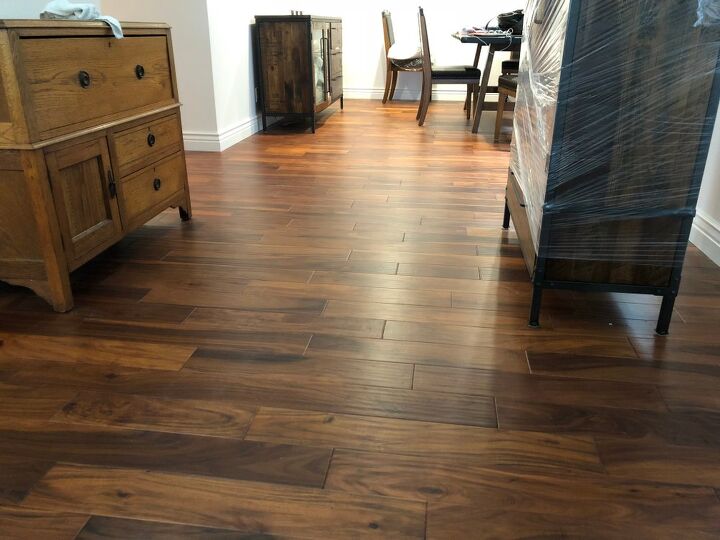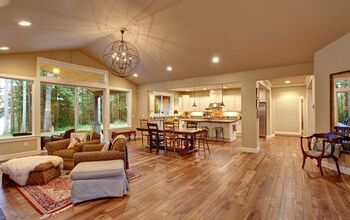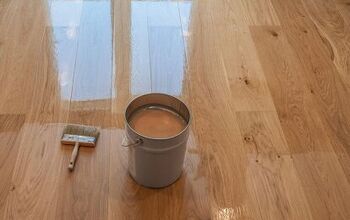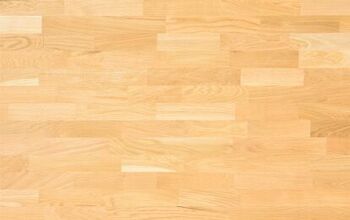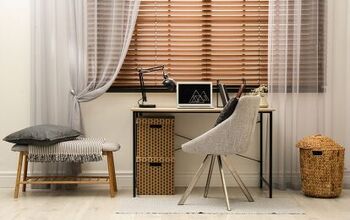What Are The Pros And Cons Of Handscraped Engineered Hardwood?

Handscraped hardwood flooring is a favorite in many homes, offering a warm and distinctive look to a room. Hand scraping can provide you with unique-looking floors–at a price. But, for a more affordable version, engineered hardwood also offers styles with a hand-scraped look.
Handscraped engineered hardwood features two layers of wood–a composite like plywood or OSB covered with a veneer of solid wood. They are typically less expensive than solid hardwood floors since hand-scraped styles are achieved with a machine. So, you won’t get the one-of-a-kind handcrafted look, but you won’t have to break the bank.
Undoubtedly hand scraped engineered hardwood floors have some upsides and some drawbacks. However, it really all depends on what factors are the most important to you. For example, if you aren’t overly concerned with floors actually being scraped by hand, then this point isn’t a dealbreaker.
Do You Need to Hire a Flooring Contractor?
Get free, zero-commitment quotes from pro contractors near you.

What Are Handscraped Engineered Hardwood Floors?
To better understand hand scraped engineered hardwood floors, it’s best to get an idea of hand-scraped solid hardwood.
Traditional Handscraped Solid Hardwood Floors
Typical hand-scraped hardwood features a series of marks and grooves that give the wood a timeless look. It’s a great match for rustic styles, modern farmhouse design, or achieving the look of a more historic home.
Many people even opt for the look within more modern spaces. Solid hardwood features one piece of solid wood throughout. Originally, hand scraping was done by artisans that achieved the various knicks, grooves, and other characteristics by hand.
These artists could use a variety of tools to achieve a unique look on each plank. Some of these tools include things like:
- Saw blades
- Hammers
- Chains
- Wire brushes
- Drills
- Ice picks
- Nuts and bolts
- Chisels
Furthermore, artists might add other elements to the planks, including resins, fillers, and other features.
Handscraped Engineered Hardwood Floors
In comparison to solid wood floors, engineered hardwood floors are not one solid piece of wood. Instead, engineered hardwood features layers of different woods put together, but they are still 100% wood floors.
Typically, it’s a composite core like plywood topped with a solid wood veneer. The top layer is where the hand scraping look occurs, but it is not done by hand.
If the various tools used for hand scraping solid wood were used on engineered wood, it wouldn’t work out well. These various tools would likely bust through the top layer, ruining the wood and the look.
Instead, with engineered wood, the hand scraping is achieved with a machine in the factory. So, what are the ups and downs of a hand scraped engineered hardwood floor?
The Pros of Handscraped Engineered Hardwood Flooring
Here are some of the primary advantages of hand-scraped engineered hardwood floors.
Handscraped Floors Offer a Unique Look
Hand-scraped floors provide a more distinctive look to your home, giving your floors depth and texture. This can be a welcome switch from overly smooth, typical hardwood floors that can lack the personality you desire.
Handscraped Engineered Wood Is Durable
Engineered wood tends to be more durable than solid hardwood flooring. It features a durable finish that can make it withstand lots of abuse over time.
Engineered hardwood also features a variety of fibers from different wood species, increasing its resistance to rot. They also help protect the wood more from things like water, insects, humidity, and sunlight. Therefore, your engineered hardwood floors will be less susceptible to things like warping, rotting, and fading.
You Can Find Wider Planks Of More Wood Species
You can usually opt for wider planks since engineered hardwood flooring can stand up better to various conditions. This is because the wood is less susceptible to rot and warping, making wider planks possible.
Handscraped Engineered Wood Hides Blemishes
The whole idea of hand-scraped wood is to fill it with grooves, scratches, and knicks. All of these design elements mean the flooring will hide expected wear and tear better.
You Can Put Handscraped Engineered Wood In More Places
Thanks to its stronger durability and ability to withstand harsher environmental conditions, you can put engineered hardwood flooring in more places. Areas that would typically be a non-no for solid hardwood are more amenable to engineered hardwood, like bathrooms and basements.
Also, abuse from pet claws and kids won’t be as noticeable when you use hand scraped engineered floors. Still, don’t install any type of hardwood floor outside or in areas prone to lots of water.
It’s Easy To Install
When you use solid hardwood, you need to put down special underlayments first. This translates to higher installation and material costs and more labor. But, engineered hardwood can go directly on top of a subfloor.
You can even put it directly on concrete, although in this case, a moisture barrier is recommended. Furthermore, many engineered flooring styles feature multiple ways to install it.
You can nail it, staple it, glue it, or even use a click-together design that fits together like a big puzzle. This latter installation process, called a floating floor, makes installing your hardwood floor a manageable DIY project. Solid hardwood floors call for nailing or gluing, significantly reducing your installation options and requiring more care and skill.
Handscraped Engineered Hardwood Floors Costs Less
Since engineered hardwood features cheaper wood on the bottom layer and a solid veneer, you’ll pay less. Plus, the hand scraping is done with a machine, not by hand, translating to another cost saver.
Environmentally-Friendly
Engineered hardwood uses plywood and other composites as the bottom layer. Meaning, wood that might have otherwise gone to waste ends up in the flooring. This helps cut down on construction waste and adds to the sustainability of wood floors.
The Cons of Handscraped Engineered Hardwood Flooring
The pros definitely outweigh the cons when it comes to hand scraped engineered hardwood flooring. Still, you need to know the big picture when you’re making your decision.
You Can’t Refinish Handscraped Engineered Hardwood Often
Depending on the finished texture and top layer of your flooring, you likely can only refinish it a few times. In many cases, with hand scraped engineered hardwood, you can’t refinish it at all. The top layer just doesn’t have enough there to withstand sanding and re-sanding.
Engineered Hardwood Flooring Is Not Waterproof
Of course, solid hardwood isn’t waterproof either, but many people mistake engineered hardwood as being waterproof. However, it’s important to distinguish being more moisture resistant from being waterproof.
Engineered hardwood is still 100% wood. So, if you need waterproof flooring, opt for something like tile or waterproof vinyl.
Handscraped Engineered Hardwood Isn’t As Unique Looking
Although hand scraping provides a more unique look than smooth hardwood, engineered wood won’t give you a one-of-a-kind look like solid hardwood. Since the hand scraping is done with a machine, it will look more uniform from plank to plank.
Tips For Finding The Best Handscraped Engineered Hardwood Flooring
When shopping for engineered hardwood flooring, look for planks with a thicker veneer layer. Also, opt for a plywood base with at least five plies. Basically, the more, the better, as the more plies and thicker the veneer, the more durable the floor.
Certain wood species take better to hand scraping than others. Many domestic species and softer woods, like oak, pine, and walnut, are great options. Harder woods, like teak, while more durable, won’t always turn out looking as well when hand scraped.
What Is The Best Way To Clean Handscraped Engineered Hardwood Floors?
Handscraped engineered hardwood floors are super easy to maintain. Use a microfiber cloth to dust mop the floor weekly and deep clean every few months with a wet mop. Use mild detergent for stubborn stains and dirt, and always wipe up spills ASAP.
Do You Need to Hire a Flooring Contractor?
Get free, zero-commitment quotes from pro contractors near you.

Related Questions
Are engineered hardwood floors the same as laminate flooring?
No, engineered hardwood is natural wood, whereas laminate flooring is not an organic material. The top layer of laminate flooring consists of manufactured elements. This makes laminate a less expensive option, but it won’t add as much value to your home as wood flooring. Also, with the addition of man-made products, you increase the likelihood of toxic substances, like VOCs, in your flooring. So, if you opt for laminate flooring, look for non-toxic and low VOC varieties.
How thick is engineered hardwood flooring?
You will typically find engineered hardwood flooring with planks anywhere from ⅜ of an inch to ¾ of an inch thick. The most common are between ⅜ and ½ of an inch.This overall thickness is about the same as a plank for a solid hardwood floor. However, engineered hardwood floors can also come with a thickness slightly less than solid hardwood. So, it’s a good option when you’re concerned about your new hardwood raising your floors too much. Take the thickness of your flooring into consideration when shopping. Make sure it will work well in your space and with any thresholds.
How much do hand scraped engineered hardwood floors cost?
Hardwood floors are some of the most expensive flooring options, ranging broadly based on wood type. The average is about $6 to $10 per square foot installed, but it can go as high as $20 or more. A total project averages $4,500, but of course, it depends greatly on the room size and wood species.
Related Guide

Stacy Randall is a wife, mother, and freelance writer from NOLA that has always had a love for DIY projects, home organization, and making spaces beautiful. Together with her husband, she has been spending the last several years lovingly renovating her grandparent's former home, making it their own and learning a lot about life along the way.
More by Stacy Randall



